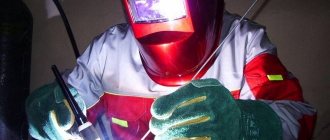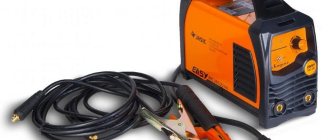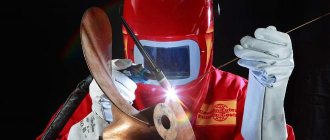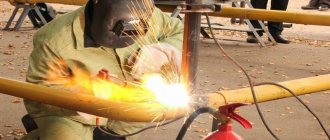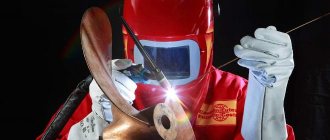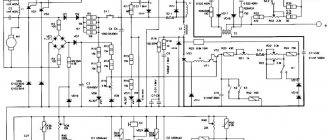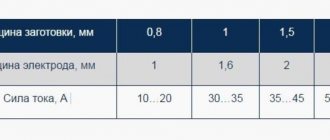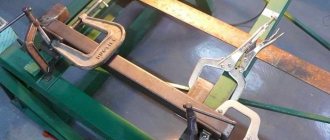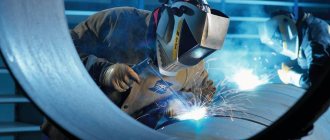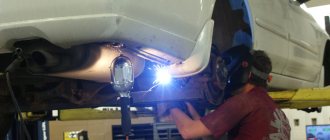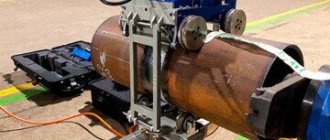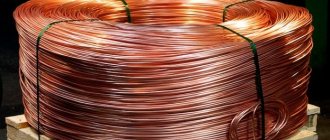Inverter welding power source
,
IIST
,
A welding inverter
is one type of power source for a welding arc.
The main purpose of all welding sources is to ensure stable combustion of the welding arc and its easy ignition. One of the most important parameters of the welding process is its resistance to vibrations and interference. There are several types of welding arc power sources - transformers, diesel or gasoline electric generators, rectifiers and inverters. The inverter welding current source appeared in the 20th century, and at the beginning of the 21st century it became one of the most popular welding machines for all types of arc welding.
Operating principle of the inverter
As already noted, inverters entered the practice of welding not so long ago, at the end of the twentieth century. The operation of devices of this type is based on the principle of voltage shift. This solution allows you to increase the strength and frequency of the current. It should be noted that the device of the inverter used for the work contains a rather complex circuit, within which the following processes are implemented:
Inverter welding machines
- The alternating current supplied to the inverter is converted to direct current. The change in current parameters occurs in the device, which is assembled using a diode bridge.
- The resulting current is transmitted to the inverter, which plays the role of a high-frequency pulse generator. In the transistor unit, the reverse conversion of direct current to alternating current occurs. But the resulting current has a significantly higher frequency than that coming from the power supply.
- High frequency current is supplied to the transformer. This device reduces the voltage and simultaneously increases the current. Since the transformer, which is used to work with high-frequency currents, has small dimensions, all this affects the overall weight characteristics of the inverter.
- After passing through the transformer, alternating current with new parameters is supplied to the rectifier, where it is again transformed into direct current, which is used for welding.
Welding with an inverter for beginners
It should be noted that inverter devices, unlike transformer-type devices, consume half the amount of energy. In addition, the parameters of the current that comes from the device ensure that the welding arc will have stable ignition and combustion during welding.
Technical parameters of devices
Welding inverters have a number of specific characteristics by which one can judge its technological properties. These include the following parameters:
Welding inverter design
- The type of current that is generated at the output of the rectifier.
- The amount of voltage that is used to supply electricity. Manufacturers produce products that operate on 380 and 220 V. The former are used for professional welding, the latter for work at home.
- Current size, this parameter has a direct impact on the size of the electrode that will be used to perform the weld.
Technical parameters of welding inverter
- Unit power, this parameter provides information about the current and strength that will form the welding arc.
- Open circuit voltage, this parameter shows how quickly the welding arc will be produced.
- The range of electrode sizes that will be used for welding.
- Dimensional and weight characteristics of the inverter welding machine and the size of the welding current at the output. The lower the last indicator, the smaller the device, but accordingly such a device has lower performance characteristics.
Pros and cons of inverter welding
Inverter devices show efficiency in the range of 85 - 95%, I must say that this is a high figure among electronic equipment. The circuit used allows you to adjust the level of welding current from several amperes to hundreds, or even thousands.
For example, an inverter of the MMA brand, it is 20 - 220 A. Inverters can operate for a long time. The power supply can be controlled remotely. The undoubted advantages of inverters include their small size and weight characteristics, which allow the device to be moved at the welding site. The design of the devices uses double insulation, ensuring electrical safety.
Technological advantages
The use of inverters allows the use of electrodes of any brand that work with both direct and alternating current. Devices of this type can be used for welding with a non-consumable electrode in a shielding gas environment. In addition, the design of this equipment makes it easy to automate welding processes.
Tungsten electrodes for argon arc welding
Electrodes for resistance welding
Welding can be performed using a short arc, thus reducing energy losses and increasing the quality of the weld; in particular, there is virtually no welding spatter on the surface of the parts being welded. By the way, the use of inverters allows you to produce seams in any spatial configuration.
Microprocessor
Microprocessors are used to control modern welding inverters, and this ensures a stable connection between voltage and current.
Disadvantages of inverters
Inverters are somewhat more difficult to repair than traditional transformer units. If some control elements located on the board fail, repairs can cost about a third of the cost of a new welding inverter.
Inverters, unlike other types of equipment, are very susceptible to dust. That is, such devices must be serviced more often. Operation of an inverter welding machine is also limited by low temperatures. In addition, there are some restrictions on storing the inverter at sub-zero temperatures. This is fraught with the formation of condensation, which can lead to a short circuit on the board.
Duration of load
When choosing a welding inverter, it is very important to pay attention to the load duration indicator. For modern models it can range from 6 to 100%.
Load duration is the ratio of the operating time of the device to the time it must cool. For working with stick electrodes (MMA, TIG), a five-minute welding cycle is taken as a standard, for semi-automatic welding – a ten-minute cycle.
That is, if in the characteristics of the MMA welding inverter the load duration is indicated at 60%, it means that it can work for 3 minutes and must cool down for two. For machines with MIG/MAG welding mode, this time would be 6 and 4 minutes, respectively.
Most manufacturers indicate the percentage taking into account the ambient temperature of 20-25 degrees Celsius. There are brands that indicate the percentage based on a temperature of 40 degrees. Their equipment will have some margin of operating time at room temperature.
How to choose a 220 V welding machine for home and garden
When selecting welding equipment, the consumer must decide what tasks it will be needed for.
If it is used for repairing body parts, then it should have some parameters, and if it is used for the production of metal structures, then it should have different parameters. But in any case, the devices must meet a number of requirements, in particular, functions such as hot start, anti-sticking and some others must be implemented in a home device. This is how inverters differ from traditional devices.
A fan must be installed in the design of this type of device. In addition, the circuit must be protected from power surges. In principle, a device with such parameters can work both in a home workshop and in industrial production conditions.
Welding equipment - what it is, types, features
Metal welding is used in many industries, construction, and even in solving small household issues. To make an even seam, you need to have skills and equipment. Welding equipment is everything that a welder needs to work. These include special welding devices, protective elements, and consumables. Using all this, it is possible to combine most metals at the molecular level. The final product is durable and will last a long time. The welding technology that the worker must master depends on the type of welding machine. The choice of welding method depends on the task at hand.
Inverter classification
Welding inverters can be classified by the size of the welding current. Manufacturers produce three types of devices:
- 100-160 A – low-power;
- 160-200 A - average;
- 200-250 A - powerful.
There is a relationship between the size of the current and the dimensions of the device. When choosing a device for use at home, you should be guided by the tasks that they have to solve.
The weakest devices can be classified as devices of the lowest level; many use them to gain work skills. Devices that are classified as middle class are among the most popular and allow you to perform a wide variety of work, from assembling a fence and manufacturing quite complex metal structures. The most powerful devices are mostly used for production purposes. They are used for working with rolled metal of large thickness.
Electrodes for manual arc welding
Most inverters are designed to work with coated electrodes. But they can also be used to work with welding wire. To do this, a device is installed on the device that feeds the wire into the welding zone. The wire is fed through the welding gun, and the gas mixture is also fed through it, protecting the working area from exposure to atmospheric air.
Additional functions in inverters
Modern inverter devices implement some options that significantly facilitate the welder’s work:
- Hot start - often novice welders, and not only them, have difficulty igniting and maintaining the arc in working condition. At the moment of ignition, the current rises to the required level and immediately after ignition returns to operating parameters. The process of changing the current occurs completely automatically, without the participation of the welder.
- Another problem that plagues beginners is electrode sticking. There are several reasons for this, but there is only one solution - reducing the level of welding current. This operation is also performed automatically.
- Arc forcing allows you to make seams in different spatial positions.
- Reducing the no-load voltage to a level that is safe for the worker and his surrounding people.
An excerpt characterizing the Inverter welding power source
“Long time no see,” he said, “thanks for coming.” I’ll just get home and Ilyushka will appear with the choir. “I came to see you,” Rostov said, blushing. Dolokhov did not answer him. “You can bet,” he said. Rostov remembered at that moment a strange conversation he once had with Dolokhov. “Only fools can play for luck,” Dolokhov said then. – Or are you afraid to play with me? - Dolokhov said now, as if he had guessed Rostov’s thought, and smiled. Because of his smile, Rostov saw in him the mood of spirit that he had during dinner at the club and in general at those times when, as if bored with daily life, Dolokhov felt the need to get out of it in some strange, mostly cruel, act . Rostov felt awkward; he searched and did not find a joke in his mind that would respond to Dolokhov’s words. But before he could do this, Dolokhov, looking straight into Rostov’s face, slowly and deliberately, so that everyone could hear, said to him: “Do you remember, we talked to you about the game... a fool who wants to play for luck.” ; I probably should play, but I want to try. “Try for luck, or perhaps?” thought Rostov. “And it’s better not to play,” he added, and cracking the torn deck, he added: “Bank, gentlemen!” Moving the money forward, Dolokhov prepared to throw. Rostov sat down next to him and did not play at first. Dolokhov glanced at him. - Why don’t you play? - said Dolokhov. And strangely, Nikolai felt the need to take a card, put a small jackpot on it and start the game. “I have no money with me,” said Rostov. - I’ll believe it! Rostov bet 5 rubles on the card and lost, bet again and lost again. Dolokhov killed, that is, he won ten cards in a row from Rostov. “Gentlemen,” he said, after spending some time, “please put money on the cards, otherwise I might get confused in the accounts.” One player said he hoped he could be trusted. – I can believe it, but I’m afraid of getting confused; “Please put money on the cards,” Dolokhov answered. “Don’t be shy, we’ll get even with you,” he added to Rostov. The game continued: the footman, without ceasing, served champagne. All Rostov's cards were broken, and up to 800 tons of rubles were written on him. He was about to write 800 thousand rubles on one card, but while he was being served champagne, he changed his mind and wrote the usual jackpot again, twenty rubles. “Leave it,” said Dolokhov, although he did not seem to look at Rostov, “you’ll get even sooner.” I give to others, but I beat you. Or are you afraid of me? - he repeated. Rostov obeyed, left the written 800 and placed the seven of hearts with a torn off corner, which he picked up from the ground. He remembered her well afterwards. He placed the seven of hearts, writing 800 above it with a broken piece of chalk, in round, straight numbers; drank the served glass of warmed champagne, smiled at Dolokhov’s words, and with bated breath, waiting for the seven, began to look at Dolokhov’s hands holding the deck. Winning or losing this seven of hearts meant a lot for Rostov. On Sunday last week, Count Ilya Andreich gave his son 2,000 rubles, and he, who never liked to talk about financial difficulties, told him that this money was the last one until May, and that is why he asked his son to be more economical this time. Nikolai said that this was too much for him, and that he gave his word of honor not to take any more money until spring. Now 1,200 rubles of this money remained. Therefore, the seven of hearts meant not only a loss of 1,600 rubles, but also the need to change this word. With a sinking heart, he looked at Dolokhov’s hands and thought: “Well, quickly, give me this card, and I’ll take my cap, go home to dinner with Denisov, Natasha and Sonya, and I’ll certainly never have a card in my hands.” At that moment, his home life, jokes with Petya, conversations with Sonya, duets with Natasha, a picket with his father, and even a calm bed in the Cook's house, presented themselves to him with such strength, clarity and charm, as if all this were long past, lost and priceless happiness. He could not allow that a stupid accident, forcing the seven to lie first on the right than on the left, could deprive him of all this newly understood, newly illuminated happiness and plunge him into the abyss of an as yet unexperienced and uncertain misfortune. This could not be, but he still waited with bated breath for the movement of Dolokhov’s hands. These broad-boned, reddish hands with hair visible from under the shirt, put down a deck of cards, and took hold of the glass and pipe being served. - So you're not afraid to play with me? - Dolokhov repeated, and, as if in order to tell a funny story, he put down the cards, leaned back in his chair and slowly began to tell with a smile: - Yes, gentlemen, I was told that there was a rumor in Moscow that I was a card sharper, so I advise you to be careful with me. - Well, swords! - said Rostov. - Oh, Moscow aunties! - said Dolokhov and took up the cards with a smile. - Aaah! – Rostov almost shouted, raising both hands to his hair. The seven he needed was already at the top, the first card in the deck. He lost more than he could pay. “However, don’t get too carried away,” said Dolokhov, glancing briefly at Rostov and continuing to throw. After an hour and a half, most of the players were already jokingly looking at their own game. The whole game focused on Rostov alone. Instead of one thousand six hundred rubles, a long column of numbers was written down behind him, which he had counted up to the tenth thousand, but which now, as he vaguely assumed, had already risen to fifteen thousand. In fact, the entry already exceeded twenty thousand rubles. Dolokhov no longer listened or told stories; he followed every movement of Rostov’s hands and occasionally glanced briefly at his note behind him. He decided to continue the game until this entry increased to forty-three thousand. He chose this number because forty-three was the sum of his years added up with Sonya's years. Rostov, leaning his head on both hands, sat in front of a table covered with writings, covered in wine, and littered with cards. One painful impression did not leave him: these broad-boned, reddish hands with hair visible from under his shirt, these hands that he loved and hated, held him in their power. “Six hundred rubles, ace, corner, nine... it’s impossible to win back!... And how fun it would be at home... Jack on n... it can’t be!... And why is he doing this to me?...” Rostov thought and recalled. Sometimes he would play a big card; but Dolokhov refused to beat her, and he himself nominated the jackpot. Nicholas submitted to him, and then prayed to God, as he prayed on the battlefield on the Amsteten Bridge; then he wished that the card that would be the first to fall into his hand from a pile of curved cards under the table would save him; either he calculated how many laces there were on his jacket and with the same number of points he tried to bet a card on the entire loss, then he looked around at the other players for help, then he peered into Dolokhov’s now cold face and tried to understand what was going on inside him. “After all, he knows what this loss means to me. He can't want my death, can he? After all, he was my friend. After all, I loved him... But it’s not his fault either; What should he do when he is lucky? And it’s not my fault, he told himself. I didn't do anything wrong. Have I killed anyone, insulted anyone, or wished harm? Why such a terrible misfortune? And when did it start? Just recently I approached this table with the thought of winning a hundred rubles, buying my mother this box for her name day and going home. I was so happy, so free, cheerful! And I didn’t understand then how happy I was! When did this end, and when did this new, terrible state begin? What marked this change? I still sat in this place, at this table, and still chose and pushed out cards, and looked at these big-boned, dexterous hands. When did this happen, and what happened? I am healthy, strong and still the same, and still in the same place. No, it can't be! It’s true that all this will not end in anything.”
Determining the characteristics
Like any technical equipment, welding inverters have a number of technical parameters that determine their capabilities.
Welding current
Inverter welding machines provide the generation of welding current in the range from 100 to 250 A.
Open circuit voltage
After converting the current supplied from the electrical network to 220 V, a current with a voltage of 50 - 90 V and an operating frequency of 20 - 50 kHz is obtained at the output of the device. Maximum voltage must be used to ignite the arc, but this creates a safety hazard for the welder and surrounding people. Therefore, after finishing work, the voltage drops to a safe level.
Maximum current operating mode
An important indicator of the operation of any welding machine is the operating time. It may be called PN or PV. This indicator indicates how long the device will operate with a ten-minute welding cycle before shutting down.
In other words, if the duty cycle is 50%, this means that the effective operating time will be 5 minutes, if the indicator is 70%, then the time will be 7 minutes. This indicator must be reflected in the technical documentation included in the delivery of the welding machine.
Input voltage
Welding inverters are powered from a standard city (220 V) or three-phase network (380 V). Household appliances can be connected to a regular outlet. Professional ones can be compatible with a three-phase power supply. Sometimes a welding inverter provides both connection options. There are no efficient battery inverters yet.
When choosing, you need to pay attention not only to the type of connection to the electrical network, but also to the sensitivity of the inverter to voltage drops. For urban networks, a deviation of 10-15% in any direction is quite likely, but almost all models are designed for such jumps.
At the same time, if the inverter is supposed to be connected to an autonomous generator or voltage surges in the network are possible within 20-30%, it is necessary to select equipment with protection against surges. This model will cost a little more, but there will be no additional problems during operation.
